Deck 51: Animal Development
Question
Question
Question
Question
Question
Question
Question
Question
Question
Question
Question
Question
Question
Question
Question
Question
Question
Question
Question
Question
Question
Question
Question
Question
Question
Question
Question
Question
Question
Question
Question
Question
Question
Question
Question
Question
Question
Question
Question
Question
Question
Question
Question
Question
Question
Question
Question
Question
Question
Question
Question
Question
Question
Question
Question
Question
Question
Question
Question
Question
Question
Question
Question
Question
Question
Question
Question
Question
Question
Question
Question
Question
Question
Question
Question
Question
Question
Question
Question
Question

Unlock Deck
Sign up to unlock the cards in this deck!
Unlock Deck
Unlock Deck
1/117
Play
Full screen (f)
Deck 51: Animal Development
1
The fast block to polyspermy involves the
A) release of inhibitors of acrosomal enzymes.
B) synthesis of a new sperm-resistant membrane.
C) accumulation of calcium ions in the acrosome.
D) opening of ion channels that change the polarity of the egg membrane.
E) destruction of excess bindin receptors on the sperm.
A) release of inhibitors of acrosomal enzymes.
B) synthesis of a new sperm-resistant membrane.
C) accumulation of calcium ions in the acrosome.
D) opening of ion channels that change the polarity of the egg membrane.
E) destruction of excess bindin receptors on the sperm.
D
2
Figure 51-1

Which of the stages or structures in the accompanying figure was formed by the process of gastrulation?
A) 1
B) f
C) g
D) 3
E) 5

Which of the stages or structures in the accompanying figure was formed by the process of gastrulation?
A) 1
B) f
C) g
D) 3
E) 5
E
3
Which of the following consists of a hollow ball of cells?
A) Gastrula
B) Morula
C) Blastula
D) Blastocoel
E) Zygote
A) Gastrula
B) Morula
C) Blastula
D) Blastocoel
E) Zygote
C
4
In sea urchins, the plasma membranes of sperm and egg fuse, and a ______ is formed that contracts to draw the sperm into the egg
A) acrosomal net
B) capacitation network
C) polyspermy barrier
D) fertilization cone
E) granulation expansion
A) acrosomal net
B) capacitation network
C) polyspermy barrier
D) fertilization cone
E) granulation expansion

Unlock Deck
Unlock for access to all 117 flashcards in this deck.
Unlock Deck
k this deck
5
Following cleavage of the zygote, although the cell number ____, the embryo ______ in size.
A) increases; decreases
B) increases; increases
C) decreases; increases
D) decreases; decreases
E) increases; does not increase
A) increases; decreases
B) increases; increases
C) decreases; increases
D) decreases; decreases
E) increases; does not increase

Unlock Deck
Unlock for access to all 117 flashcards in this deck.
Unlock Deck
k this deck
6
In amphibian development, the blastula consists of many small cells in the _____ hemisphere and fewer but larger cells in the ______ hemisphere.
A) animal; vegetal
B) animal; animal
C) vegetal; vegetal
D) vegetal; animal
E) totipotent; telolecithal
A) animal; vegetal
B) animal; animal
C) vegetal; vegetal
D) vegetal; animal
E) totipotent; telolecithal

Unlock Deck
Unlock for access to all 117 flashcards in this deck.
Unlock Deck
k this deck
7
In most animals, the sperm and egg contribute an equal ____ to the zygote.
A) amount of cytoplasm
B) number of chromosomes
C) number of enzymes
D) number of mitochondria
E) number of ribosomes
A) amount of cytoplasm
B) number of chromosomes
C) number of enzymes
D) number of mitochondria
E) number of ribosomes

Unlock Deck
Unlock for access to all 117 flashcards in this deck.
Unlock Deck
k this deck
8
If the sperm and egg are of the same species, ______, a species-specific protein located on the _______, adheres to receptors located on the egg's ________.
A) acrosomin; acrosome; jelly coat
B) bindin; acrosome; vitelline membrane
C) bindin; acrosome; zona pellucida
D) acrosomin; zona pellucida, jelly coat
E) bindin, head, vitelline membrane
A) acrosomin; acrosome; jelly coat
B) bindin; acrosome; vitelline membrane
C) bindin; acrosome; zona pellucida
D) acrosomin; zona pellucida, jelly coat
E) bindin, head, vitelline membrane

Unlock Deck
Unlock for access to all 117 flashcards in this deck.
Unlock Deck
k this deck
9
Which of the following indicates the correct sequence of mammalian egg coverings, beginning at the outside and moving inward?
A) Plasma membrane, jelly coat, zona pellucida
B) Zona pellucida, vitelline envelope, plasma membrane
C) Vitelline envelope, plasma membrane, jelly coat
D) Granulosa cells, zona pellucida, plasma membrane
E) Zona pellucida, granulosa cells, plasma membrane
A) Plasma membrane, jelly coat, zona pellucida
B) Zona pellucida, vitelline envelope, plasma membrane
C) Vitelline envelope, plasma membrane, jelly coat
D) Granulosa cells, zona pellucida, plasma membrane
E) Zona pellucida, granulosa cells, plasma membrane

Unlock Deck
Unlock for access to all 117 flashcards in this deck.
Unlock Deck
k this deck
10
Which of the following statements about fertilization is TRUE?
A) Fertilization restores the haploid chromosome number.
B) Fertilization stimulates the initiation of development.
C) Fertilization cannot determine the sex of the offspring.
D) Fertilization permits the formation of gametes with new genetic combinations.
E) In fertilization, a sperm fuses with an ovum to produce an embryo.
A) Fertilization restores the haploid chromosome number.
B) Fertilization stimulates the initiation of development.
C) Fertilization cannot determine the sex of the offspring.
D) Fertilization permits the formation of gametes with new genetic combinations.
E) In fertilization, a sperm fuses with an ovum to produce an embryo.

Unlock Deck
Unlock for access to all 117 flashcards in this deck.
Unlock Deck
k this deck
11
What is the correct sequence of sea urchin egg coverings, beginning at the inside and moving outward?
A) Granulosa cells, zona pellucida, plasma membrane
B) Zona pellucida, vitelline envelope, plasma membrane
C) Jelly coat, vitelline envelope, plasma membrane
D) Plasma membrane, zona pellucida, jelly coat
E) Vitelline envelope, jelly coat, plasma membrane
A) Granulosa cells, zona pellucida, plasma membrane
B) Zona pellucida, vitelline envelope, plasma membrane
C) Jelly coat, vitelline envelope, plasma membrane
D) Plasma membrane, zona pellucida, jelly coat
E) Vitelline envelope, jelly coat, plasma membrane

Unlock Deck
Unlock for access to all 117 flashcards in this deck.
Unlock Deck
k this deck
12
Figure 51-1

What type of cleavage pattern is represented in the accompanying figure?
A) Holoblastic and radial
B) Holoblastic and spiral
C) Meroblastic and radial
D) Meroblastic and spiral
E) Holoblastic and mosaic

What type of cleavage pattern is represented in the accompanying figure?
A) Holoblastic and radial
B) Holoblastic and spiral
C) Meroblastic and radial
D) Meroblastic and spiral
E) Holoblastic and mosaic

Unlock Deck
Unlock for access to all 117 flashcards in this deck.
Unlock Deck
k this deck
13
Most invertebrates have
A) isolecithal eggs and meroblastic cleavage.
B) telolecithal eggs and meroblastic cleavage.
C) isolecithal eggs and holoblastic cleavage.
D) telolecithal eggs and holoblastic cleavage.
E) isolecithal eggs and radial cleavage.
A) isolecithal eggs and meroblastic cleavage.
B) telolecithal eggs and meroblastic cleavage.
C) isolecithal eggs and holoblastic cleavage.
D) telolecithal eggs and holoblastic cleavage.
E) isolecithal eggs and radial cleavage.

Unlock Deck
Unlock for access to all 117 flashcards in this deck.
Unlock Deck
k this deck
14
Before a sperm can participate in fertilization, it must undergo ____ in the female reproductive tract.
A) the acrosome reaction
B) the cortical reaction
C) spermatogenesis
D) determination
E) capacitation
A) the acrosome reaction
B) the cortical reaction
C) spermatogenesis
D) determination
E) capacitation

Unlock Deck
Unlock for access to all 117 flashcards in this deck.
Unlock Deck
k this deck
15
Cell division of the blastula is restricted to which of the following?
A) Animal pole
B) Vegetal pole
C) Blastomere
D) Blastodisc
E) Blastocoel
A) Animal pole
B) Vegetal pole
C) Blastomere
D) Blastodisc
E) Blastocoel

Unlock Deck
Unlock for access to all 117 flashcards in this deck.
Unlock Deck
k this deck
16
Animal growth primarily occurs by an increase in the
A) number of tissues and organs.
B) number of cells.
C) types of cells produced.
D) number of cell functions.
E) number of cell shapes.
A) number of tissues and organs.
B) number of cells.
C) types of cells produced.
D) number of cell functions.
E) number of cell shapes.

Unlock Deck
Unlock for access to all 117 flashcards in this deck.
Unlock Deck
k this deck
17
The principle of nuclear equivalence states that
A) developing cells become specialized to carry out specific functions.
B) developing cells follow particular differentiation pathways.
C) there is no loss of genetic information through determination or differentiation.
D) differential gene expression is responsible for variation among cells.
E) nuclear changes can take place during the entire life of an individual.
A) developing cells become specialized to carry out specific functions.
B) developing cells follow particular differentiation pathways.
C) there is no loss of genetic information through determination or differentiation.
D) differential gene expression is responsible for variation among cells.
E) nuclear changes can take place during the entire life of an individual.

Unlock Deck
Unlock for access to all 117 flashcards in this deck.
Unlock Deck
k this deck
18
What is the correct sequence through which early development proceeds?
A) morula → zygote → gastrula → blastula
B) zygote → blastula → morula → gastrula
C) zygote → blastula → gastrula → morula
D) zygote → gastrula → blastula → morula
E) zygote → morula → blastula → gastrula
A) morula → zygote → gastrula → blastula
B) zygote → blastula → morula → gastrula
C) zygote → blastula → gastrula → morula
D) zygote → gastrula → blastula → morula
E) zygote → morula → blastula → gastrula

Unlock Deck
Unlock for access to all 117 flashcards in this deck.
Unlock Deck
k this deck
19
Figure 51-1

The structure labeled as 2 in the accompanying figure is the
A) endoderm layer.
B) mesoderm layer.
C) blastopore.
D) blastocoel.
E) archenteron.

The structure labeled as 2 in the accompanying figure is the
A) endoderm layer.
B) mesoderm layer.
C) blastopore.
D) blastocoel.
E) archenteron.

Unlock Deck
Unlock for access to all 117 flashcards in this deck.
Unlock Deck
k this deck
20
Which statement about sperm entry is TRUE?
A) The fertilization cone formed by microvilli of the egg membrane contracts and draws the sperm inward.
B) The egg phagocytizes the acrosome of the sperm so it can enter the cell.
C) The cilia on the egg membrane beat and sweep the sperm inside.
D) The sperm releases calcium ions, which make the egg membrane permeable to its entry.
E) The egg secretes bindin protein, which allows sperm penetration.
A) The fertilization cone formed by microvilli of the egg membrane contracts and draws the sperm inward.
B) The egg phagocytizes the acrosome of the sperm so it can enter the cell.
C) The cilia on the egg membrane beat and sweep the sperm inside.
D) The sperm releases calcium ions, which make the egg membrane permeable to its entry.
E) The egg secretes bindin protein, which allows sperm penetration.

Unlock Deck
Unlock for access to all 117 flashcards in this deck.
Unlock Deck
k this deck
21
Figure 51-2 Use the figure to answer the corresponding question(s).

The developmental stage represented in the accompanying figure is a(n)
A) morula.
B) early blastula.
C) late blastula.
D) early gastrula.
E) middle gastrula.

The developmental stage represented in the accompanying figure is a(n)
A) morula.
B) early blastula.
C) late blastula.
D) early gastrula.
E) middle gastrula.

Unlock Deck
Unlock for access to all 117 flashcards in this deck.
Unlock Deck
k this deck
22
Which structure do cells that make up the upper layer (the epiblast) and migrate toward the midline form?
A) Archenteron
B) Primitive streak
C) Chorion
D) Primitive groove
E) Notochord
A) Archenteron
B) Primitive streak
C) Chorion
D) Primitive groove
E) Notochord

Unlock Deck
Unlock for access to all 117 flashcards in this deck.
Unlock Deck
k this deck
23
Figure 51-2 Use the figure to answer the corresponding question(s).
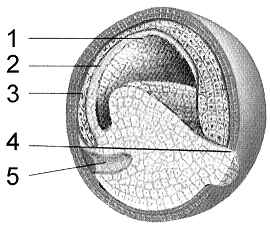
Refer to the accompanying figure. Which structure is the blastocoel?
A) 1
B) 2
C) 3
D) 4
E) 5

Refer to the accompanying figure. Which structure is the blastocoel?
A) 1
B) 2
C) 3
D) 4
E) 5

Unlock Deck
Unlock for access to all 117 flashcards in this deck.
Unlock Deck
k this deck
24
Figure 51-2 Use the figure to answer the corresponding question(s).
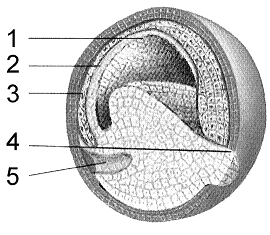
The structure labeled as 3 in Figure 51-2 is the
A) archenteron.
B) endoderm.
C) mesoderm.
D) blastocoel.
E) ectoderm.

The structure labeled as 3 in Figure 51-2 is the
A) archenteron.
B) endoderm.
C) mesoderm.
D) blastocoel.
E) ectoderm.

Unlock Deck
Unlock for access to all 117 flashcards in this deck.
Unlock Deck
k this deck
25
Figure 51-4
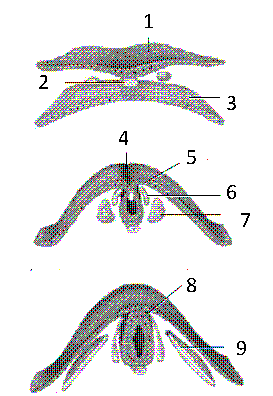
Refer to the accompanying figure. Which structure is from a different germ layer than the rest?
A) 2
B) 3
C) 6
D) 7
E) 8

Refer to the accompanying figure. Which structure is from a different germ layer than the rest?
A) 2
B) 3
C) 6
D) 7
E) 8

Unlock Deck
Unlock for access to all 117 flashcards in this deck.
Unlock Deck
k this deck
26
Which organism exhibits radial cleavage?
A) Echinoderms
B) Amphibians
C) Mollusks
D) Annelids
E) Birds
A) Echinoderms
B) Amphibians
C) Mollusks
D) Annelids
E) Birds

Unlock Deck
Unlock for access to all 117 flashcards in this deck.
Unlock Deck
k this deck
27
Which of the following arises from the mesoderm?
A) Pituitary gland
B) Inner layer of skin
C) Chorion
D) Outer layer of skin
E) Lining of respiratory system
A) Pituitary gland
B) Inner layer of skin
C) Chorion
D) Outer layer of skin
E) Lining of respiratory system

Unlock Deck
Unlock for access to all 117 flashcards in this deck.
Unlock Deck
k this deck
28
Which of the following becomes the ectoderm during gastrulation?
A) Epiblast
B) Hyoplast
C) Ectoblast
D) Notochord
E) Hensen's node
A) Epiblast
B) Hyoplast
C) Ectoblast
D) Notochord
E) Hensen's node

Unlock Deck
Unlock for access to all 117 flashcards in this deck.
Unlock Deck
k this deck
29
Figure 51-4
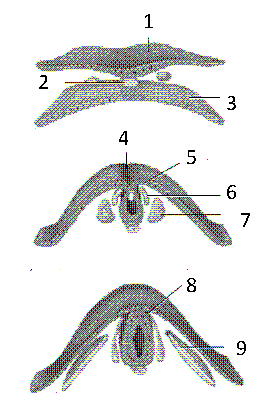
Refer to the accompanying figure. The structure labeled as 2 is the
A) neural plate
B) neural fold
C) notochord
D) somite
E) neural crest

Refer to the accompanying figure. The structure labeled as 2 is the
A) neural plate
B) neural fold
C) notochord
D) somite
E) neural crest

Unlock Deck
Unlock for access to all 117 flashcards in this deck.
Unlock Deck
k this deck
30
The first system to develop in the vertebrate embryo is the
A) circulatory system.
B) digestive system.
C) excretory system.
D) reproductive system.
E) nervous system.
A) circulatory system.
B) digestive system.
C) excretory system.
D) reproductive system.
E) nervous system.

Unlock Deck
Unlock for access to all 117 flashcards in this deck.
Unlock Deck
k this deck
31
A primitive groove is the equivalent of a
A) neural crest.
B) branchial groove.
C) blastodisc.
D) blastopore.
E) neural groove.
A) neural crest.
B) branchial groove.
C) blastodisc.
D) blastopore.
E) neural groove.

Unlock Deck
Unlock for access to all 117 flashcards in this deck.
Unlock Deck
k this deck
32
Embryonic mesoderm forms the
A) epidermis.
B) digestive tract lining.
C) pituitary gland.
D) excretory system.
E) nervous system.
A) epidermis.
B) digestive tract lining.
C) pituitary gland.
D) excretory system.
E) nervous system.

Unlock Deck
Unlock for access to all 117 flashcards in this deck.
Unlock Deck
k this deck
33
The term "archenteron" refers to the developing
A) gut.
B) lung.
C) notochord.
D) nerve tube.
E) skin.
A) gut.
B) lung.
C) notochord.
D) nerve tube.
E) skin.

Unlock Deck
Unlock for access to all 117 flashcards in this deck.
Unlock Deck
k this deck
34
The gray crescent region of the amphibian zygote is thought to contain
A) growth factors and developmental determinants.
B) hormones and ribosomes.
C) yolk and dark pigment granules.
D) mitochondria and ribosomes.
E) neurotransmitters and hormones.
A) growth factors and developmental determinants.
B) hormones and ribosomes.
C) yolk and dark pigment granules.
D) mitochondria and ribosomes.
E) neurotransmitters and hormones.

Unlock Deck
Unlock for access to all 117 flashcards in this deck.
Unlock Deck
k this deck
35
If the ectoderm is destroyed, which organ systems will not form?
A) Musculoskeletal system
B) Digestive system
C) Nervous system
D) Circulatory system
E) Excretory system
A) Musculoskeletal system
B) Digestive system
C) Nervous system
D) Circulatory system
E) Excretory system

Unlock Deck
Unlock for access to all 117 flashcards in this deck.
Unlock Deck
k this deck
36
Figure 51-4
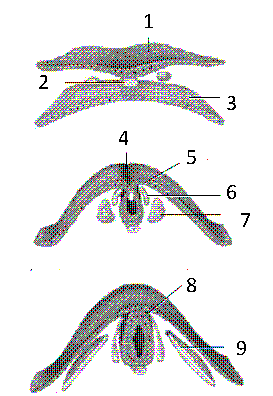
Refer to the accompanying figure. Which structure gives rise to the spinal cord?
A) 1
B) 2
C) 5
D) 8
E) 9

Refer to the accompanying figure. Which structure gives rise to the spinal cord?
A) 1
B) 2
C) 5
D) 8
E) 9

Unlock Deck
Unlock for access to all 117 flashcards in this deck.
Unlock Deck
k this deck
37
Embryonic mesoderm gives rise to
A) muscle.
B) the lining of the digestive tract.
C) the nervous system.
D) sense organs.
E) lining of the respiratory system.
A) muscle.
B) the lining of the digestive tract.
C) the nervous system.
D) sense organs.
E) lining of the respiratory system.

Unlock Deck
Unlock for access to all 117 flashcards in this deck.
Unlock Deck
k this deck
38
Which statements about the notochord is FALSE?
A) It is lost when it is replaced by the spinal cord.
B) It develops in chordate embryos.
C) It develops from mesodermal tissue.
D) It induces formation of the neural plate.
E) It grows along the longitudinal axis of the organism.
A) It is lost when it is replaced by the spinal cord.
B) It develops in chordate embryos.
C) It develops from mesodermal tissue.
D) It induces formation of the neural plate.
E) It grows along the longitudinal axis of the organism.

Unlock Deck
Unlock for access to all 117 flashcards in this deck.
Unlock Deck
k this deck
39
Figure 51-4
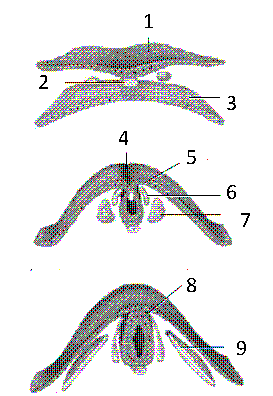
Refer to the accompanying figure. Which structure can be transferred to a different location in the embryo and still cause differentiation of surrounding tissues?
A) 1
B) 2
C) 5
D) 6
E) 8

Refer to the accompanying figure. Which structure can be transferred to a different location in the embryo and still cause differentiation of surrounding tissues?
A) 1
B) 2
C) 5
D) 6
E) 8

Unlock Deck
Unlock for access to all 117 flashcards in this deck.
Unlock Deck
k this deck
40
Figure 51-2 Use the figure to answer the corresponding question(s).
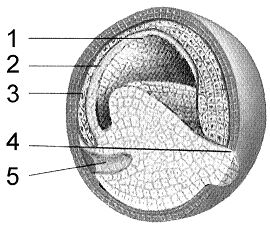
The developing embryo in the accompanying figure is representative of development in a(n)
A) bird.
B) annelid.
C) sea star.
D) frog.
E) mammal.

The developing embryo in the accompanying figure is representative of development in a(n)
A) bird.
B) annelid.
C) sea star.
D) frog.
E) mammal.

Unlock Deck
Unlock for access to all 117 flashcards in this deck.
Unlock Deck
k this deck
41
Figure 51-3
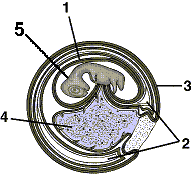
Refer to the accompanying figure. The amnion is identified by number
A) 1
B) 2
C) 3
D) 4
E) 5

Refer to the accompanying figure. The amnion is identified by number
A) 1
B) 2
C) 3
D) 4
E) 5

Unlock Deck
Unlock for access to all 117 flashcards in this deck.
Unlock Deck
k this deck
42
Briefly explain how cell differentiation relates to pattern formation an animal.

Unlock Deck
Unlock for access to all 117 flashcards in this deck.
Unlock Deck
k this deck
43
Which of the following are incorrectly paired?
A) Heroin−premature births and low birth weight
B) Thalidomide−babies born without toes
C) Accutane−associated with malformations of the brain
D) Cocaine−constricts fetal arteries, which leads to retarded development
E) Cigarette smoking−an addiction to nicotine
A) Heroin−premature births and low birth weight
B) Thalidomide−babies born without toes
C) Accutane−associated with malformations of the brain
D) Cocaine−constricts fetal arteries, which leads to retarded development
E) Cigarette smoking−an addiction to nicotine

Unlock Deck
Unlock for access to all 117 flashcards in this deck.
Unlock Deck
k this deck
44
Which statement about early embryonic development in humans is FALSE?
A) The embryo is moved along the oviduct by ciliary action and muscular contraction.
B) The embryo develops through the blastula stage while floating free in the uterus.
C) The embryo enters the uterus about 24 hours after fertilization.
D) Early division of the embryo occurs in the oviduct.
E) Implantation of the embryo occurs about seven days after fertilization.
A) The embryo is moved along the oviduct by ciliary action and muscular contraction.
B) The embryo develops through the blastula stage while floating free in the uterus.
C) The embryo enters the uterus about 24 hours after fertilization.
D) Early division of the embryo occurs in the oviduct.
E) Implantation of the embryo occurs about seven days after fertilization.

Unlock Deck
Unlock for access to all 117 flashcards in this deck.
Unlock Deck
k this deck
45
The extraembryonic membrane closest to the embryo is the
A) amnion.
B) archenteron.
C) chorion.
D) blastocyst.
E) neural plate.
A) amnion.
B) archenteron.
C) chorion.
D) blastocyst.
E) neural plate.

Unlock Deck
Unlock for access to all 117 flashcards in this deck.
Unlock Deck
k this deck
46
The percentage of twins being born has increased in the past 20 years because of
A) the increased use of fertility inducing drugs.
B) increases in hospital care.
C) the desire of more couples to have twins.
D) the increased use of thalidomide.
E) the increased incidence of German measles.
A) the increased use of fertility inducing drugs.
B) increases in hospital care.
C) the desire of more couples to have twins.
D) the increased use of thalidomide.
E) the increased incidence of German measles.

Unlock Deck
Unlock for access to all 117 flashcards in this deck.
Unlock Deck
k this deck
47
The function of the chorion is to
A) absorb shock.
B) form blood cells.
C) provide nourishment.
D) permit freedom of movement.
E) permit gas exchange.
A) absorb shock.
B) form blood cells.
C) provide nourishment.
D) permit freedom of movement.
E) permit gas exchange.

Unlock Deck
Unlock for access to all 117 flashcards in this deck.
Unlock Deck
k this deck
48
A human embryo is capable of movement and has gonads that are distinguishable as either testes or ovaries by the end of the
A) second week.
B) fourth week.
C) sixth week.
D) eighth week.
E) first trimester.
A) second week.
B) fourth week.
C) sixth week.
D) eighth week.
E) first trimester.

Unlock Deck
Unlock for access to all 117 flashcards in this deck.
Unlock Deck
k this deck
49
The embryo becomes implanted in the endometrium of the uterus due to
A) special receptors on the endometrium to which the blastocyst attaches.
B) enzymes secreted by the trophoblast, which erode an area of the endometrium for entry of the embryo.
C) special phagocytic cells in the endometrium, which engulf the embryo.
D) the sticky coat of the zona pellucida, which adheres to the endometrium.
E) the action of hCG secreted by the embryo.
A) special receptors on the endometrium to which the blastocyst attaches.
B) enzymes secreted by the trophoblast, which erode an area of the endometrium for entry of the embryo.
C) special phagocytic cells in the endometrium, which engulf the embryo.
D) the sticky coat of the zona pellucida, which adheres to the endometrium.
E) the action of hCG secreted by the embryo.

Unlock Deck
Unlock for access to all 117 flashcards in this deck.
Unlock Deck
k this deck
50
Place the following in developmental order beginning with the earliest event.
(1) Limb buds appear
(2) Face begins to look human
(3) Muscles differentiate
(4) Downy hair covers the fetus
(5) Sex can be determined by external inspection
A) 3, 1, 2, 4, 5
B) 1, 3, 4, 2, 5
C) 1, 3, 2, 5, 4
D) 1, 2, 3, 4, 5
E) 1, 3, 5, 2, 4
(1) Limb buds appear
(2) Face begins to look human
(3) Muscles differentiate
(4) Downy hair covers the fetus
(5) Sex can be determined by external inspection
A) 3, 1, 2, 4, 5
B) 1, 3, 4, 2, 5
C) 1, 3, 2, 5, 4
D) 1, 2, 3, 4, 5
E) 1, 3, 5, 2, 4

Unlock Deck
Unlock for access to all 117 flashcards in this deck.
Unlock Deck
k this deck
51
The trophoblast secretes ____, which signals the corpus luteum that pregnancy has begun.
A) estrogen
B) a gray crescent
C) progesterone
D) hCG
E) an enzyme
A) estrogen
B) a gray crescent
C) progesterone
D) hCG
E) an enzyme

Unlock Deck
Unlock for access to all 117 flashcards in this deck.
Unlock Deck
k this deck
52
Which structure is the most immediate precursor of the brain?
A) Neural tube
B) Neural groove
C) Neural crest
D) Neural folds
E) Neural plate
A) Neural tube
B) Neural groove
C) Neural crest
D) Neural folds
E) Neural plate

Unlock Deck
Unlock for access to all 117 flashcards in this deck.
Unlock Deck
k this deck
53
Monozygotic twins
A) occur when two eggs are ovulated.
B) may be of different sexes.
C) have different sets of genes.
D) are called identical twins.
E) result from the fertilization of two sperm cells.
A) occur when two eggs are ovulated.
B) may be of different sexes.
C) have different sets of genes.
D) are called identical twins.
E) result from the fertilization of two sperm cells.

Unlock Deck
Unlock for access to all 117 flashcards in this deck.
Unlock Deck
k this deck
54
In mammals, the ____ is a temporary center for the formation of blood cells.
A) amnion
B) allantois
C) yolk sac
D) chorion
E) archenteron
A) amnion
B) allantois
C) yolk sac
D) chorion
E) archenteron

Unlock Deck
Unlock for access to all 117 flashcards in this deck.
Unlock Deck
k this deck
55
Briefly explain the relationship between nuclear equivalence and differential gene expression.

Unlock Deck
Unlock for access to all 117 flashcards in this deck.
Unlock Deck
k this deck
56
A teratogen is a drug that
A) increases fertility.
B) prevents fertilization.
C) prevents implantation of the embryo in the endometrium.
D) induces labor.
E) interferes with morphogenesis.
A) increases fertility.
B) prevents fertilization.
C) prevents implantation of the embryo in the endometrium.
D) induces labor.
E) interferes with morphogenesis.

Unlock Deck
Unlock for access to all 117 flashcards in this deck.
Unlock Deck
k this deck
57
The first breath of the neonate is initiated by the
A) passage through the birth canal.
B) removal of amniotic fluid from its mouth.
C) accumulation of carbon dioxide in the blood.
D) detection of light by its visual receptors.
E) increase in oxygen concentration in the lungs.
A) passage through the birth canal.
B) removal of amniotic fluid from its mouth.
C) accumulation of carbon dioxide in the blood.
D) detection of light by its visual receptors.
E) increase in oxygen concentration in the lungs.

Unlock Deck
Unlock for access to all 117 flashcards in this deck.
Unlock Deck
k this deck
58
Figure 51-3
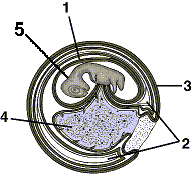
Refer to the accompanying figure. The chorion is identified by number
A) 1
B) 2
C) 3
D) 4
E) 5

Refer to the accompanying figure. The chorion is identified by number
A) 1
B) 2
C) 3
D) 4
E) 5

Unlock Deck
Unlock for access to all 117 flashcards in this deck.
Unlock Deck
k this deck
59
In humans, the allantois
A) stores embryonic nitrogenous wastes.
B) eliminates nitrogenous wastes from the embryo.
C) contributes to the formation of the blood vessels in the umbilical cord.
D) secretes amniotic fluid.
E) serves as a temporary center for formation of blood cells.
A) stores embryonic nitrogenous wastes.
B) eliminates nitrogenous wastes from the embryo.
C) contributes to the formation of the blood vessels in the umbilical cord.
D) secretes amniotic fluid.
E) serves as a temporary center for formation of blood cells.

Unlock Deck
Unlock for access to all 117 flashcards in this deck.
Unlock Deck
k this deck
60
Figure 51-3

Refer to the accompanying figure. The allantois is identified by number
A) 1
B) 2
C) 3
D) 4
E) 5

Refer to the accompanying figure. The allantois is identified by number
A) 1
B) 2
C) 3
D) 4
E) 5

Unlock Deck
Unlock for access to all 117 flashcards in this deck.
Unlock Deck
k this deck
61
Using one sentence each and in the correct order, describe the four processes involved in fertilization.

Unlock Deck
Unlock for access to all 117 flashcards in this deck.
Unlock Deck
k this deck
62
In the amphibian embryo, the first cleavage bisects the gray crescent.

Unlock Deck
Unlock for access to all 117 flashcards in this deck.
Unlock Deck
k this deck
63
Programmed cell death is called apoptosis.

Unlock Deck
Unlock for access to all 117 flashcards in this deck.
Unlock Deck
k this deck
64
As part of the fertilization process, the egg completes meiosis I.

Unlock Deck
Unlock for access to all 117 flashcards in this deck.
Unlock Deck
k this deck
65
An embryo having a blastodisc exhibits holoblastic cleavage.

Unlock Deck
Unlock for access to all 117 flashcards in this deck.
Unlock Deck
k this deck
66
Identify two changes that occur at or shortly after birth that allow the neonate to live independently.

Unlock Deck
Unlock for access to all 117 flashcards in this deck.
Unlock Deck
k this deck
67
Gastrulation is the process by which an embryo becomes three-layered.

Unlock Deck
Unlock for access to all 117 flashcards in this deck.
Unlock Deck
k this deck
68
List the fate of each of the three germ layers.

Unlock Deck
Unlock for access to all 117 flashcards in this deck.
Unlock Deck
k this deck
69
In echinoderms, gastrulation takes place through a primitive groove.

Unlock Deck
Unlock for access to all 117 flashcards in this deck.
Unlock Deck
k this deck
70
When a human embryo is implanted in the uterus, the embryo is in the morula stage.

Unlock Deck
Unlock for access to all 117 flashcards in this deck.
Unlock Deck
k this deck
71
The chorion is the extraembryonic membrane closest to the embryo proper.

Unlock Deck
Unlock for access to all 117 flashcards in this deck.
Unlock Deck
k this deck
72
The blastopore is the opening to the blastocoel.

Unlock Deck
Unlock for access to all 117 flashcards in this deck.
Unlock Deck
k this deck
73
During capacitation, sperm become mature.

Unlock Deck
Unlock for access to all 117 flashcards in this deck.
Unlock Deck
k this deck
74
In birds and reptiles, the allantois stores nitrogenous wastes.

Unlock Deck
Unlock for access to all 117 flashcards in this deck.
Unlock Deck
k this deck
75
Isolecithal eggs exhibit holoblastic cleavage.

Unlock Deck
Unlock for access to all 117 flashcards in this deck.
Unlock Deck
k this deck
76
The fertilization envelope forms when the plasma membranes of sperm and egg fuse.

Unlock Deck
Unlock for access to all 117 flashcards in this deck.
Unlock Deck
k this deck
77
The blastula can be described as an embryo consisting of a hollow sphere of cells.

Unlock Deck
Unlock for access to all 117 flashcards in this deck.
Unlock Deck
k this deck
78
Outside the zona pellucida is a layer of granulosa cells.

Unlock Deck
Unlock for access to all 117 flashcards in this deck.
Unlock Deck
k this deck
79
The eggs of birds and reptiles are telolecithal.

Unlock Deck
Unlock for access to all 117 flashcards in this deck.
Unlock Deck
k this deck
80
The notochord induces the neural plate.

Unlock Deck
Unlock for access to all 117 flashcards in this deck.
Unlock Deck
k this deck



